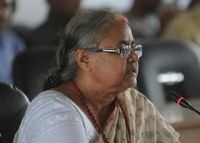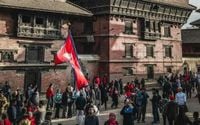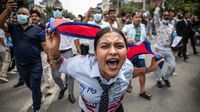In the wake of the explosive Gen Z protests that shook Nepal on September 8 and 9, 2025, the country is grappling with a profound sense of loss, uncertainty, and a fragile hope for renewal. What began as a youth-led movement against corruption, mismanagement, and proposed social media regulations escalated into a violent upheaval, leaving 75 people dead and more than 2,000 injured, according to reporting by Tribhuvan University and Nepali Times. The nation’s capital, Kathmandu, became the epicenter of this unrest, with its streets witnessing scenes of chaos, grief, and heroism.
The economic impact was staggering. The Federation of Nepalese Chambers of Commerce and Industry estimated that arson and looting caused approximately US $571 million in losses to private property. This figure is particularly striking given that the private sector accounts for about 81 percent of Nepal’s national economy and generates 86 percent of private sector jobs. The destruction wasn’t limited to private assets; historic public buildings, including the Office of the Prime Minister at Singh Durbar, the parliament, the Supreme Court, and the President’s office at Rashtrapati Bhawan, were damaged, though the full cost is still being tallied.
The government’s response was swift but fraught with challenges. An interim government was installed on September 12 under the leadership of former Chief Justice Sushila Karki, who has since expanded her cabinet to eight ministers. The government’s primary mandate is to conduct free, fair, and credible elections within the next six months, aiming for March 2026. To address the aftermath, a three-member commission led by former Justice Gauri Bahadur Karki was established to investigate human rights violations and document losses within three months. However, a controversial statement from the Home Minister—declaring that complaints of arson or theft would not be entertained since the commission was already handling these issues—has sparked criticism for potentially undermining the regular criminal justice process.
Voter registration has been opened for 90 days, with a special focus on enrolling the young people who took part in the protests. The Prime Minister has held consultations with the Election Commission and political parties, and the President has urged all parties to participate in the upcoming elections. Yet, there is a palpable pressure on the established parties to reform, develop a stronger democratic culture, and make way for younger leadership. Many citizens are calling for the leadership of major parties—the Nepali Congress, CPN-UML, and Maoist Center—to step down and allow fresh faces to emerge.
The Gen Z movement, however, remains fragmented. Lacking centralized leadership, various unorganized groups have emerged on platforms like Discord, and opinions are split on whether to engage with existing political structures or push for constitutional amendments, such as a directly elected Prime Minister. Some youth groups have formed a coalition to negotiate with stakeholders, while others are exploring the option of registering a new political party rather than contesting as independents. Despite these efforts, no formal agreement has been reached with the government, and the risk of renewed violence looms if divisions persist.
The unrest also exposed deep vulnerabilities in Nepal’s security apparatus. During the protests, mobs attacked 486 police units, looted 1,247 arms, and destroyed numerous police posts. The Department of Prison Management reported that 15,000 prisoners escaped from 28 prisons nationwide, with only half returning voluntarily; some were even apprehended in New Delhi, India. The lack of coordination among Nepal’s three main security agencies—the Police, Nepal Armed Force, and Nepal Army—was glaring, with the police left to respond first and other forces delayed in their deployment.
According to Kathmandu Post, the Nepal Police are now grappling with trauma and a crisis of confidence. Officers described harrowing experiences: some were forced to remove their uniforms and flee through sewage drains to survive, while others were subjected to humiliation and violence. "The image of colleagues brutally beaten to death before our eyes is still fresh," recounted one officer. Although police operations outside Kathmandu have largely resumed, the psychological scars remain. Police spokesperson Binod Ghimire acknowledged the difficulty in returning to normal duties but credited community support with helping to rebuild police infrastructure and morale. Yet, as one senior officer noted, "Some colleagues may indeed require post-trauma healing, and it’s the organisation’s responsibility to recognise that and do the needful."
The trauma was not limited to law enforcement. Journalists covering the protests faced their own ordeals. Sunita Karki of Annapurna Post recounted watching police beat a teenager and witnessing her newsroom set ablaze. "I cried a lot," she said, torn between her duty as a journalist and her shock as a citizen. Photojournalist Angad Dhakal lost ten years of work when protesters torched the Kantipur National Daily office. He described the moment: "My office was burning. What should I photograph?" Others, like Gaurav Pokharel of OnlineKhabar, had to hide their press IDs and blend in with protesters to avoid attacks. Even public broadcasting was targeted, with protestors setting fire within the Singha Durbar complex housing Nepal Television and Radio Nepal. Despite the chaos, journalists managed to keep the 8 pm news on air via a regional link, a small victory amid the turmoil.
In the aftermath, the government imposed travel restrictions on five individuals, including former Prime Minister K. P. Oli and former Home Minister Ramesh Lekhak, a move that has drawn objections from the CPN-UML and raised concerns about politically motivated investigations. The Kathmandu District Administration Office has since banned all demonstrations, assemblies, and motorcycle rallies, citing security concerns as rival groups threaten further protests, including a movement led by controversial businessman Durga Prasai demanding the restoration of monarchy after the Tihar and Chhath festivals.
With the interim government under pressure to stabilize the nation, conduct credible elections, and restore public trust, the road ahead remains uncertain. The legacy of violence, the culture of impunity, and the psychological toll on both the police and the press are challenges that cannot be ignored. The coming months will test Nepal’s resilience and its commitment to democratic renewal, as the country seeks not just to recover, but to transform in the wake of its youthquake.


